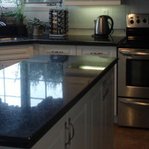If you are thinking of renovating your home, you have probably thought about the type of countertops you would like to use in areas such as the kitchen or bath. So what options do you have? What is the best product for your home and family? Are there less expensive options? What are the pros and cons of granite or marble? What about Corian or other solid surface counters? When is using a Formica or laminate countertop appropriate? What are the pros and cons? How long are any of these options expected to last?
I bet you didn’t know there were so many options! The market is literally flooded with countertop choices in a wide range of price points and materials. Here a few currently popular countertops. Inform yourself and choose wisely...
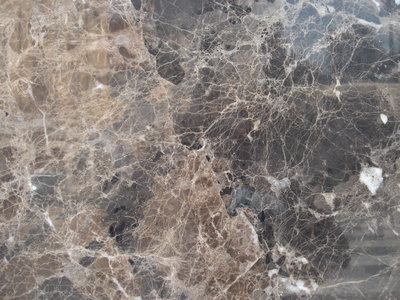 Laminate
Laminate
For many years laminate countertops were very popular, as well as inexpensive. Familiar brand names of laminate manufacturers include companies like Formica, Wilsonart and Nevamar.
The pros: Laminate is a very good product for a price conscious consumer. Generally, it holds up well for long periods of time. Maintenance involves simply wiping it down with typical soap and water, no special chemical cleaners or sealers are required. Because it is made of a hard plastic, it is very resilient and cleans up well. There are almost an unlimited array of colors and textures available that range from basic matte one color finishes to exotic multi-toned, granite looking textured finishes. There is certainly something for everyone in the world of laminate colors.
The cons: Laminate is made of a thin layer of plastic resin which is adhered to a composite wood material. This means that if the plastic is worn down from repeated use over many years it is susceptible to scratching, cracking or simply wearing off so the material underneath shows through. And if the countertop is not adequately supported from below or is exposed to excessive moisture, it can lead issues with bending or bowing. The sizes of the sheets of plastic are limited and may require seams to accommodate an unusual shape or size countertop, although a good designer will know this in advance and be sure to plan the tops to have limited seams. There is no way to affordably resurface them if they become damaged, so these are the most disposable tops for any job.
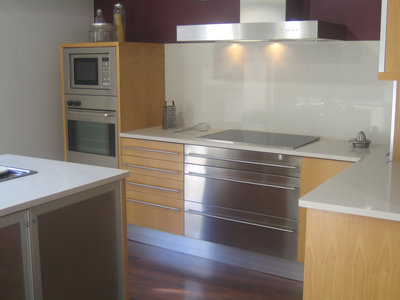 Solid Surface
Solid Surface
Solid surface countertops like Corian, Wilsonart solid surface or Avonite make for a highly durable countertop with a wide variety of colors and patterns. Good fabricators have the ability to install a seamless looking top with this material.
Pros: Solid surface counters are made of high grade plastic resin mixtures and usually have very long warranties that are included with purchase. They have the advantage of being made of the solid color all the way through, meaning it is highly durable, any scratches or damages can be buffed out by professsionals, and seams can be joined to become seamless looking. These tops can be left as a matte finish or be highly polished for an extra high sheen. Edge profiles are numerous and come in a wide variety of styles. No special maintenance is required, however it is recommended to avoid using rough scouring agents or harsh scrubbing pads to clean them. Thinner sheets of this product can be used for the walls of shower areas or be used as a backsplash material. Bathroom countertops with the sink and counter all connected in one solid piece are easy to keep clean and last a very long time.
Cons: Over time very dark colors do show surface scratches. A matte finish is standard and the cost of buffing to achieve a high polish is more expensive. Some solid surface countertops are more affordable in standard colors, but still are at least double the cost of laminate tops. The more exotic colors and finishes can be as expensive as a high grade granite top. These tops are not natural or biodegradable.
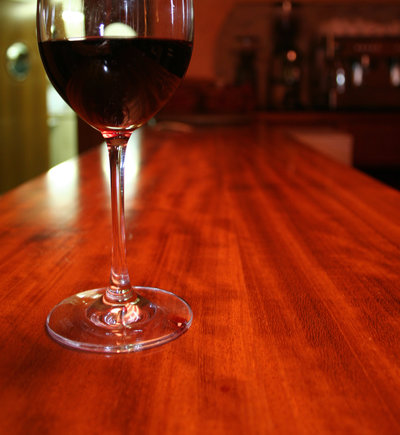 Wood Countertops
Wood Countertops
Wood countertops and butcher blocks have always been a popular choice. Natural wood is a beautiful, durable and great countertop choice. Wood counters can be laminated together length wise which shows off the grain of the wood. This is called a “flat grain” or plank style. This look is popular in kitchens, furniture, for bar tops, or servers. Wood tops around a sink or wet area can be done, but all exposed edges must be sealed with an extremely durable polyurethane that will protect the wood from scratches, water stains, mold and marks from glasses or permanent stains. Once the topcoat has cured, it becomes extremely durable.
End grain butcher blocks have the cut ends of the blocks of wood oriented so that the finished surface resembles a chessboard. These are the types of wood tops that are perfect for cutting on, can be easily sanded down and resurfaced as needed, so they make a great long term choice for the avid cook. The graining of the wood actually accommodates sharp knives so your knives will not become damaged by repeated use. This type of top is usually finished with a food grade oil based finish which will need to be re-applied at least monthly, based upon the amount of use it gets. Good natural oils to use for this purpose are Tung Oil or Mineral Oil.
Pros: Not only are wood tops a healthy choice being they are a natural product, but they are also a sustainable and biodegradable choice as well. Finishing can give you a wide range of color choices to choose from. Refinishing is possible down the road, which makes these a great long term investment; keep in mind that refinishing installed tops is a huge job, so avoiding damages is a good idea. A good water resistant top coat will protect from most water damages and stains and make it easy to keep clean. Wood tops can be used with undermount sinks as long as they are finished appropriately for the area of use. Unique pieces of refurbished and reclaimed wood are very stylish and can be requested from most manufacturers. Pricing will vary based upon the grain, stain, style, edge profile, species of wood and size required.
Cons: Wood is very sensitive to climate, changes in humidity or temperature. If it is exposed to dramatic temperature changes or extreme changes in humidity, this can result in cracking at the edges, bowing, or warping, so plan accordingly and keep your tops away from direct heat sources, ventilation ductwork and steam. Avoid leaving wet glasses and hot pots or dishware on the surface of a wood top for any length of time. Never cut directly on wood tops that are not made specifically to be butcherblocks to avoid damage.
 Quartz Countertops
Quartz Countertops
Quartz countertops have recently hit the residential market as a fantastic alternative to natural stone and granite. Natural quartz is mined from the ground and mixed with resins and colors and compressed under high pressure and heat to create countertops that are beautiful, durable and non-porous. Manufacturers such as Cambria, Silestone, Hanstone, Caesarstone and Zodiac have been serving the architectural and commercial industry for many, many years. These slabs are made in standard sizes and most are imported from all over the world. Almost all quartz tops have a lifetime warranty. Some are treated with anti-bacterial technology and they never can get stained or have to be sealed. They can be fabricated just like granite and marble with a wide variety of colors and edge profiles.
Pros: Quartz is a beautiful, non-porous product, is available in a wide array of colors and at a variety of price points. These countertops will never have to be sealed or treated with any kind of special maintenance. Regular soap and water will do the trick. Lifetime warranties are generally standard and included in the cost. One quartz manufacturer makes their slabs right here in the USA, for homeowners who prefer products that support our local economy. This product is generally less expensive than granite or marble. It can be used in kitchens, bathrooms and wet areas and is extremely durable. The colors have a “seamless” look, even with seams or use of multiple slabs due to the consistency of the product and colors. Slabs are available in 2cm which can be used as a backsplash, and a 3cm thickness which are just about the same thickness of most granite slabs.
Cons: Man-made products like quartz generally do not have the natural flowing characteristics and veining that natural marble and exotic granite slabs contain. Quartz slabs have similar limitations as natural stone with regard to sizes, seams or possible damage from excessive force or repeated trauma (such as dropping heavy pots or utensils on the edges).
Marble
Marble has been used in homes for thousands of years. It is a beautiful, luxurious product that is available in numerous colors, sizes and colors. Marble slabs can range in price from the low end for standard, widely available colors to extremely costly, one of kind colors and exotic slabs. It can yield a breathtaking end result and can suit a wide variety of purposes.
Pros: This distinct product has a telltale veining and milky look. The colors tend toward lighter tones but can also be vibrant, dark and exotic. Marble is a delicate product and must be fabricated and installed with extreme care by an experienced crew, but once properly installed, it will last for many, many years. Stains can be avoided with regular sealing; some stains may be removable with poultices.
Cons: Marble is extremely porous. This means it’s “pores” will absorb whatever is left in prolonged contact with it. Staining is very common. In bathrooms mildew, water stains and rusting of shower hinges for instance can leave permanent stains. In a kitchen, oils, acidic fruits and vegetables, red wine, and other household items will leave permanent marks and give the stone a very “lived-in” look over time. Sealing the stone very regularly will help delay the stains from penetrating it, so regular maintenance is crucial. Never use strongly colored cleaners or acidic chemicals on marble. Never put raw poultry or meat directly on marble as bacteria may begin to grow inside your counter. There are no warranties on natural marble. Marble can be very slippery when wet, so it is generally not used as flooring in wet areas.
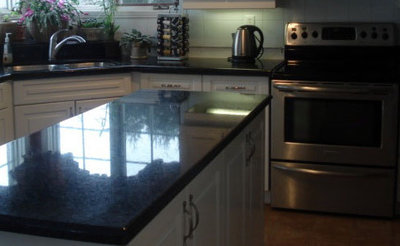 Granite
Granite
Granite is a beautiful, natural, extremely hard stone that is difficult to damage and will last for many, many years. In general, it tends to be darker with compressed patterns, and not as dramatically light and “veined” as marble, although some riverbed granites and quartzite granites have very strong veins and colors. Granite colors can range from the darkest of black to ivory and white, and have many nuances and colors in between. Standard color granites are widely available and can be relatively inexpensive compared to more exotic slabs that can be extremely costly. Each slab of granite is unique with widely varying tones, lines, speckles and patterns.
Pros: This product has become widely available in standard colors that make it somewhat sensible for a long term home improvement option and is widely used in kitchens and baths. It is highly durable and will last for many years with proper care. It is available in a wide array of colors and price points. It is a beautiful, one-of-a-kind natural product mined from the earth.
Cons: Granite is porous and very hard and cold to the touch. It must be sealed regularly to avoid permanent staining from oils, wine or food; oil stains from foods can soak into the stone if not wiped up right away (such as the lid of a jar of peanut butter left face down for a few hours). You should never cut raw meat, poultry or raw fish on granite because the bacteria can be absorbed into the countertop and cause damage to your knives. There are no warranties on natural granite. Granite will be slippery when wet so it is generally not used as flooring in wet areas.
With the multitude of countertop options available, selecting the right one for your home and your budget can be overwhelming. Hiring a kitchen and bath designer, architect or interior designer to guide you through all the selections you must make is extremely helpful and cost efficient. With their extensive experience and knowledge of the size limitations and nuances of various products, they can assist you with planning the layout correctly.
With wood, marble or granite especially, the cost is high and you want to make sure your project will look good when it is complete. A good designer will assist you in selecting the proper colors and product for your home and family, make sure the template is accurately fitted so that you are not stuck with a top that is the wrong size, and make sure the seams look right. Nothing is worse than a beautiful piece of stone that looks awful because it was poorly coordinated and the flow of the stone or difference in colors where the slabs meet looks odd. Get it right the first time and save money by hiring a professional.
Photo credit Quartz tops - Carrie Brandstrom














